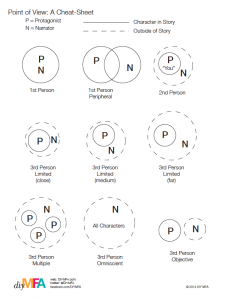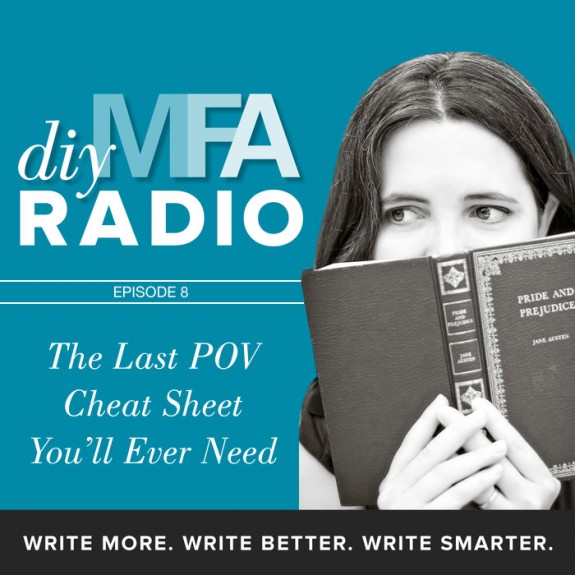Point of view is tricky and a lot of writers struggle to make sense of it. We often think of writing purely as an art but when it comes to point of view (POV), there’s definitely a science to it.
When I first started writing I had no idea what POV was all about so I created a nifty POV cheat sheet to help me remember which was which. When other writers started raving about the cheat sheet, I knew I had to share it with my listeners on this podcast.
In this episode I’ll walk you through the cheat sheet by the end, you’ll know point of view inside and out.
Sign up here to download the POV Cheat Sheet.
Point of View Cheat Sheet Key
P: Protagonist (the main character in your story)
N: Narrator (the person telling the story)
Sometimes P and N are the same character, sometimes they are not.
Solid circle: a character inside the story
Dashed line: someone outside the story
Notice how P is always in a solid circle (because the protagonist is always a character in the story) while N can either be a solid circle or a not. The circles represent what P or N know in the story–the information available to P or N.
Example: In the first person, the protagonist and narrator are one and the same so everything the narrator knows, the protagonist also knows. In a third person point of view, the narrator is outside the story so he/she has access to information that the protagonist does not know. The cheat sheet gives you a visual representation of all the basic POV options.
First person is when the narrator is a character in the story.
First Person
This is when the main character is the person telling the story. In other words, this is the “I” narrator. Notice how the circles for the protagonist and narrator overlap. This is because the narrator can only know information that the protagonist has access to. No more, no less. Examples: Holden from Catcher in the Rye or Katniss from The Hunger Games.
First Person Peripheral
This is when the narrator is a supporting character in the story, not the main character. This is still the “I” narrator, but now the narrator is not the protagonist. In this case, the circles only overlap partially because the narrator has access to some information that the protagonist knows but not all. This means that there are events and scenes that happen in the protagonist’s life that the narrator will not have access to, making this point of view option more of a challenge. Example: Nick from The Great Gatsby (Gatsby is the protagonist).
Third person is when the narrator is NOT a character in the story.
Third Person Limited
Third person is the “he/she/it” narrator. Limited means that the POV is limited to just one character. This means that the narrator only knows what that character knows, only sees what that character sees. Examples: A Christmas Carol by Charles Dickens (where the story follows Scrooge at all times–even scenes that Scrooge would not be privy too we see through his eyes as he travels with the ghosts of Christmas past, present and future). The Book of Three (first book of the Prydain Chronicles) where the narrator follows the protagonist Taran.
Note: Third Person allows the writer to play with Narrative Distance.
Look at the second row of circles. All three are examples of third person limited, but the narrative distance changes. This means that when narrative distance is close, the narrator is right there inside the protagonist’s head, almost overlapping as we saw with the first person POV. As the narrative distance gets farther away, the narrator has access to more information outside of the protagonist’s viewpoint but also loses some of that up-close-and-personal feel we get when the the distance is zoomed in all the way.
Think of narrative distance as the writer’s zoom lens, it allows you to get close to the protagonist’s thoughts and feelings but also to pull back and get a bird’s eye view. As with a video zoom lens, you want to avoid zooming in and out too quickly or making drastic choices (unless you want your reader to feel disoriented). Still, third person allows you this wiggle room that you don’t get with the first person POV.
Third Person Multiple
Again, we’re in the “he/she/it” category, but now the narrator can follow multiple characters in the story (hence the multiple circles within the narrator’s circle). The challenge with this POV is making sure your reader knows when you’re switching from one character to another. A good way to make the switch is to use chapter breaks or section breaks to signal a new POV. Example: The High King (which is the final book of the Prydain Chronicles) where the narrator follows several characters in the story, including Taran.
Third Person Omniscient
This one still uses a “he/she/it” narration but now the narrator knows EVERYTHING in the story. The narrator isn’t limited by what the POV character knows. It’s sort of like the narrator is god, hence the term “omniscient.” This type of POV was very popular back in the day but has recently become less popular (some people feel like it’s a little old-fashioned). Still, some excellent books use this narrator. Examples: Oliver Twist by Charles Dickens, and Pride and Prejudice by Jane Austen.
Third Person Objective
Just like the omniscient narrator can get into any character’s head, the objective narrator gets into NO ONE’s mind. This means the objective narrator can only relate information that is easily visible (character’s words and actions). This narrator can’t tell us about the character’s thoughts or feelings because it doesn’t know. It’s kind of like watching a movie, where the only information you get is what you can see or hear.
This POV is very tough to sustain for long pieces which is why the only example I can find is a short story: Raymond Carver’s Little Things. In this case, notice how the narrator’s circle and the protagonist’s circle do not overlap at all. This is because the only information the narrator has access to is what can be observed externally through the protagonist’s words and actions.
Other POV Choices
Second Person
This is the “you” narrator. “You go to the store and realize you forgot your wallet… etc.” Like objective POV, the second person is hard to sustain so there are very few novels written in second person. This POV is more popular for short stories. In fact, the first story I ever published is in the second person (which is weird because I think it’s the only story I’ve ever done in second person). Example: Bright Lights, Big City by Jay McIerney
Unreliable First Person
This is when you have a first person narrator but you can’t trust him/her for any number of reasons. Maybe the character is a very young child who doesn’t really understand what’s happening in the story. Or perhaps the character is insane. Or better yet, the character could be perfectly sane but also a pathological liar so you can’t believe what she says. Example: The Tell-tale Heart by Edgar Allen Poe.
Epistolary (or other) Form
Epistolary is when the story is told in letters. There are many forms that work similarly to epistolary forms, like journal form or a story told through emails, etc. Mostly these forms work like the first person because the main character in the story is often the one writing the letters/journal/etc. The difference is that the story is limited even further because of the form. For example, people don’t usually write dialogue in their letters, so if you want to use dialogue in epistolary form, you’ll have to find a way around that.
In the end, POV is all about consistency. Whatever form you decide on, it’s important to let the reader know what the “rules” are for your story and then stick to them.
Resource Recap:

Download the POV Cheat Sheet here
Link to Episode 8
(Right-click to download.)
It’s not too late to sign up for DIY MFA 101.
Registration is open to the end of this week!
If you liked this episode…
Head over to iTunes, leave a review, and subscribe so you’ll be first to know when new episodes are available. Also, if you know anyone who might enjoy this podcast, please share!
Until next week, keep writing and keep being awesome.








